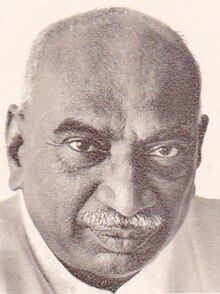K. Kamaraj | |
|---|---|
 Portrait of Kamaraj from a 1976 commemorative stamp | |
| 3rd Chief Minister of Madras State | |
| In office 13 April 1954 – 2 October 1963 | |
| Governor | |
| Preceded by | C. Rajagopalachari |
| Succeeded by | M. Bhaktavatsalam |
| Constituency |
|
| Member of Parliament, Lok Sabha | |
| In office 9 January 1969 – 2 October 1975 | |
| Prime Minister | Indira Gandhi |
| Preceded by | A. Nesamony |
| Succeeded by | Kumari Ananthan |
| Constituency | Nagercoil |
| In office 13 May 1952 – 12 April 1954 | |
| Prime Minister | Jawaharlal Nehru |
| Preceded by | position established |
| Succeeded by | U. Muthuramalingam Thevar |
| Constituency | Srivilliputhur |
| President of the Indian National Congress (Organisation) | |
| In office 12 November 1969 – 2 October 1975 | |
| Preceded by | position established |
| Succeeded by | Morarji Desai |
| President of the Indian National Congress | |
| In office 1964–1967 | |
| Preceded by | Neelam Sanjiva Reddy |
| Succeeded by | S. Nijalingappa |
| President of the Tamil Nadu Pradesh Congress Committee | |
| In office 1946–1952 | |
| Succeeded by | P. Subbarayan |
| Member of the Madras State Legislative Assembly | |
| In office 6 August 1954 – 28 February 1967 | |
| Constituency |
|
| Personal details | |
| Born | Kamatchi 15 July 1903 Virudhupatti, Madras Presidency, British India (present-day Virudhunagar district, Tamil Nadu, India) |
| Died | 2 October 1975 (aged 72) Madras, Tamil Nadu, India |
| Resting place | Perunthalaivar Kamarajar Ninaivagam |
| Political party | Indian National Congress (until 1969) Indian National Congress (O) (1969–75) |
| Residences |
|
| Occupation | |
| Awards | Bharat Ratna (1976) Copper Bond Award (1972) |
| Signature | |
| Nicknames |
|
Kumaraswami Kamaraj (15 July 1903 – 2 October 1975), popularly known as Kamarajar was an Indian independence activist and politician who served as the Chief Minister of Madras from 13 April 1954 to 2 October 1963. He also served as the president of the Indian National Congress between 1964–1967 and was responsible for the elevation of Lal Bahadur Shastri and later Indira Gandhi to the position of Prime Minister of India, because of which he was widely acknowledged as the "Kingmaker" in Indian politics during the 1960s. Later, he was the founder and president of the Indian National Congress (O).
Born as Kamatchi, Kamaraj had dropped out of school early and had little formal education. He became active in the Indian Independence movement in the 1920s and was imprisoned by the British Raj multiple times due to his activities. In 1937, Kamaraj was elected to the Madras Legislative Assembly after winning in the 1937 Madras Presidency Legislative Assembly election. He was active during the Quit India Movement in 1942, because of which he was incarcerated for three years till 1945.
After the Indian Independence, Kamaraj served as a Member of Parliament in the Lok Sabha from 1952 to 1954 before becoming the Chief Minister of Madras State in April 1954. During his almost decade long tenure as the chief minister, he played a major role in developing the infrastructure of the state and improving the quality of life of the needy and the disadvantaged. He was responsible for introducing free education to children and expanded the free Midday Meal Scheme, which resulted in significant improvement in school enrollment and growth of literacy rates in the state over the decade. He is widely known as Kalvi Thanthai (Father of education) because of his role in improving the educational infrastructure.
Kamaraj was known for his simplicity and integrity. He remained a bachelor throughout his life and did not own any property when he died in 1975. Former Vice-president of the United States Hubert Humphrey, referred to Kamaraj as one of the greatest political leaders in all the countries. He was awarded with India's highest civilian honour, the Bharat Ratna, posthumously in 1976.